- Private car and driver in Delhi / India
- +91-8447445445
- info@discoverindiabycar.com sugar.ankit@yahoo.com
 +91-9818434712
+91-9818434712
MahaShivratri

Every year, in either the month of Magha (according to the South Indian calendar) or Phalguna (according to the North Indian calendar), Hinduism celebrates Mahashivratri, a festival honouring Lord Shiva, one of the principal deities. Shivratri is celebrated every month and a total of 12 times a year, however Mahashivratri is a distinct holiday. The night that Lord Shiva performs his Tandava Nritya is known as Mahashivratri, also known as the Great Night of Shiva. The night when Shiva and Parvati were married is remembered on this day, according to another mythology. It’s now the festive season of the year.
Every year, the national holiday of Mahashivratri is greeted with great fanfare. All around the world, there are devotees of Lord Shiva who take part in the Mahashivratri celebrations. On this day, people fast and stay up late praying to the Lord for blessings, joy, hope, and prosperity. As we prepare to observe Mahashivratri this year, let’s examine its date, significance, and background.
All around the world, there are devotees of Lord Shiva who take part in the Mahashivratri celebrations. On this day, people fast and stay up late praying to the Lord for blessings, joy, hope, and prosperity. As we prepare to observe Mahashivratri this year, let’s examine its date, significance, and background.
Date
Hindus celebrate Mahashivratri to recognise Lord Shiva’s ability to shield his followers from any harm that might come their way.
History
There are various justifications for why we observe Mahasivaratri in Hindu mythology. It is thought that Lord Shiva and Lady Parvati were wed on the day of Mahashivratri. As a result, the day is celebrated every year to honour their union. To remember the day when Lord Shiva swallowed the poison that was churned up from the ocean and shielded the earth from darkness and gloom, according to another tale, is the reason why Mahashivratri is honoured.
Significance and celebrations
Mahashivratri fasting is seen as being exceedingly lucky. It is also good for the body and the mind to abstain from food and liquids for a set period of time. After breaking a fast, it is thought that Lord Shiva is pleased when people pray to him. The Lord Shiva idol is presented with milk, honey, fruits, and bel leaves. Devotees visit the temple after taking a morning wash in the Ganges. They then give their prayers to the Lord and observe a daylong fast. Om NamahShivaya is said to invoke blessings and the Lord’s fulfilment of requests and wants.

Mahashivratri celebrations
The nation as a whole celebrates Mahashivratri, including Uttarakhand, Rajasthan, Uttar Pradesh, Madhya Pradesh, Punjab, Himachal Pradesh, Bihar, Karnataka, Tamil Nadu, and Andhra Pradesh or Telangana. In Shiva temples all around the country, people perform Shiv Archana while also offering the Shivling milk, dhatura bel patra, sandalwood paste, ghee, sugar, and other bhog items. Shiv devotees fast for a full day, breaking it the next morning.
During observing the fast, devotees are permitted to eat satvik foods like buckwheat, ragi, sabudana, fruits, and some vegetables. You should follow these recommendations if you’re also fasting during Mahashivratri.

Fasting for Mahashivratri Dos
- On the morning of the day before the vrat, after taking a bath and performing Shiv Puja, one takes the sankalp for the Mahashivratri fast. The sankalp is performed by combining rice with water in the palm.
- The morning of the fast, around Brahma Muhurta or daybreak, get up early.
- One should take a bath the day before the fast and put on clean, preferably white, clothing.
- Chanting “Om NamahShivay” multiple times every day is encouraged for those who are observing this fast.








